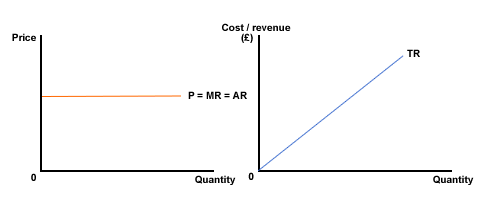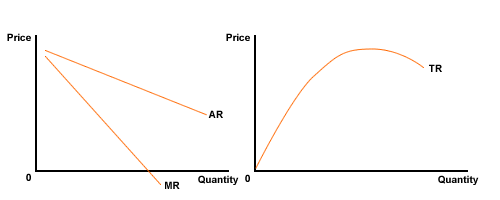Revenues - notes
Revenue is the income a firm obtains from the sales of its goods or services. Three terms must be understood:

- Total revenue (TR) - all the revenue earned by the business. Total revenue = price x quantity demanded.
- Average revenue (AR) - total revenue divided by number sold.
- Marginal revenue (MR) - the increase in total revenue as the result of one more sale. This is not necessarily the same as the price. It is only the same as price, if price remains constant.
Revenue curves vary depending on whether price is constant at all levels of output (as in the case of a firm which is a price-taker), or falls as output increases (as in the case of a firm who is a price-setter). Look at Figures 1 and 2 below to see the difference this makes to the shape of the average / marginal revenue and total revenue curves:

Figure 1 Revenue curves - constant price (price-taker)

Figure 2 Revenue curves - falling price (price-setter)
You have to be able to calculate revenue, in any form, from data, then draw and interpret curves. Time for an example, and for you to do some work again!
| Output (units) | 0 | 1 | 2 | 3 | 4 | 5 | 6 | 7 | 8 | 9 | 10 |
|---|---|---|---|---|---|---|---|---|---|---|---|
| Total revenue ($ 000) | 0 | 100 | 180 | 240 | 280 | 300 | 300 | 280 | 240 | 180 | 100 |
Plot this with output on the horizontal axis and revenue on the vertical axis. Look at it and then we will do some more calculations.
There is also a static version of this graph available.
Total revenue rose at first, reached a maximum, and then declined.

From the total revenue curve data above, now calculate the figures for marginal revenue and average revenue. Once you have had a go, click on the answer link below to check your calculations.
Answer - revenue calculations
Now, plot the marginal and average revenue curves from this data as well. Examine it. What does it tell you?
There is also a static version of this graph available.
Observation of the graph shows:
- Both AR and MR fall as output increases.
- AR and MR start at the same point on the Y-axis, at the same level of revenue.
- MR can and does become negative.
- Using the first graph as well, when MR is zero, TR is at its maximum. Output is 5.5 units.
